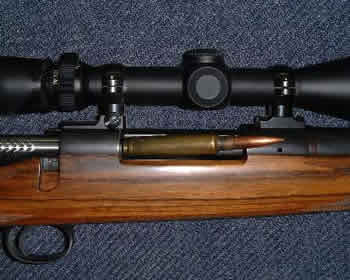378 Weatherby Cases in the Remington 700 Action?
January 23, 2015 2:33 amThe following is an answer to a question posed by PRECISION SHOOTING Editor, Dave Brennan about the wisdom of using a .378 Weatherby case in a long Remington 700 action. The following is Dan’s response and it was published in PS in the October, 1999 issue.
Dear Dave:
I don’t think your question about the compatibility of a Remington 700 action and a 416 Rigby or .378 Weatherby case is inappropriate at all. Although we no longer do any chambering work in our shop, I have experience with the big cases in a variety of actions. The short answer is; no I don’t think the Remington should be used for either of those cases.

I feel this way for several reasons. First the Remington uses a 1-1/16″ diameter thread shank with 16 threads per inch. In my opinion this leaves a marginal wall thickness between the root of the barrel thread and the chamber wall. The .378 Weatherby belt diameter is .610″ and the largest diameter of the big Rigby case is about .590″. With a thread root diameter of about .992″ or so (normal for 83% contact) that leaves a wall thickness of .191″ over the Weatherby belt. With the Rigby case the thickness is a little better at .201″ but still marginal in my opinion.
I think all of the custom actions designed for the big cases have a 1-1/8″ diameter thread shank. Much better from my viewpoint. But someone wanting to use a Remington could argue that the Weatherby MK 5 action has the same barrel thread size as the Remington. That’s true but it doesn’t change the fact that it is still marginal.
The Remington’s thread size isn’t its only shortcoming though. To make case extraction work well a Sako extractor should be installed. Opening the bolt face diameter to .600″ or bigger inside a .700″ diameter bolt leaves just .050″ wall thickness per side. Again, marginal in my opinion. But to make the Sako extractor work the outside needs to be machined away near the business end or it won’t snap over the case rim. The problem is that the extractor pivots too far beyond the .700″ diameter of the bolt nose and contacts the inside of the counterbore in the Remington-type barrel. Without removing some of the end of the extractor or opening the inside diameter of the counterbore, it won’t work. Marginal again.
Several years ago I wrote an article for Precision Shooting that determined bolt lug strength for a given bolt size and material strength. There was included in the article a computer code that also calculated bolt thrust developed from various cartridges. If we run the numbers through the program for our example here, the 378 Weatherby case and a standard Remington 700 action, we find that the bolt thrust value is about 12,760 pounds for a stiff handload (and whose aren’t?) of 65,000 PSI. The lug strength value is greater (thankfully) at about 37,770. But that isn’t near as great a margin as some lesser cartridges have in the Remington action. And with the standard repeater model the lug abuttments in the receiver are probably weaker, at least on the bottom side, than the bolt lug. The reason for this is because of the substaintial machining required for the feed ramp.
The program I used to calculate these numbers also crunches a value for lug flex at peak chamber pressure. For this example it was .0026″. This means that the cases are going to stretch this much each time they’re fired and explains why it becomes necessary to full-length rezise cases. This stretching isn’t as much of a problem with new cases because the brass retains some elasticity and returns close to its original size for a few firings.
Oh yes, one other problem with these cases in a Remington. It is a single shot only proposition. While this won’t matter to many users it might to some. My advice, when asked, is to leave the Remington 700 for smaller cases.
Best regards,
Dan Lilja

